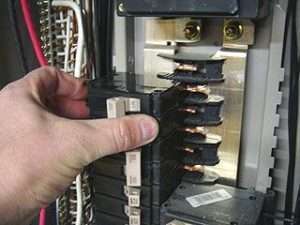Understanding Wire Breaker Size for Electric Dryers
When it comes to ensuring safety and efficient operation of your electric dryer, wire breaker size is a factor to consider. This blog post aims to deliver comprehensive information on the ideal wire breaker size for electric dryers. The right wire breaker size can prevent potential electrical hazards, ensuring your dryer operates at its best. Understanding the importance of wire breaker size for electric dryers will help homeowners avoid common mistakes, ensuring a safer and more energy-efficient home. The general answer to the question about the ideal wire breaker size is that it depends on the specific requirements of your dryer model. In this post, we’ll delve deeper into the subject, providing clear guidelines to help you make informed decisions.
Understanding Wire Breaker Size for Electric Dryers
What is a Wire Breaker?
A wire breaker, also known as a circuit breaker, is a safety device that protects electrical circuits from overloads and short circuits. It acts as a switch that automatically shuts off the flow of electricity when it detects a problem in the circuit. In the context of electric dryers, the wire breaker is responsible for protecting the dryer and the electrical wiring from potential hazards.
Why is the Wire Breaker Size Important for Electric Dryers?
The wire breaker size is key when it comes to electric dryers because it determines the maximum amount of electrical current that can safely flow through the circuit. Choosing the correct wire breaker size ensures that the dryer operates efficiently and without any risk of overloading the circuit.
If the wire breaker size is too small, it may trip frequently due to the high power demands of the dryer. On the other hand, if the wire breaker size is too large, it may not provide adequate protection in case of a fault or short circuit. Therefore, selecting the appropriate wire breaker size is essential for the safe and optimal performance of your electric dryer.
Factors to Consider when Determining Wire Breaker Size for Electric Dryers
When determining the wire breaker size for your electric dryer, several factors need to be taken into consideration. These factors include:
- Voltage and Current Requirements: Electric dryers typically operate on either 240 volts or 120/240 volts. Check the dryer’s specifications to determine the voltage requirement. Additionally, consider the current rating of the dryer, usually measured in amps.
- Wire Size: The wire size used for the circuit should be able to handle the maximum current required by the electric dryer. Refer to the National Electrical Code (NEC) or consult with a qualified electrician to ensure the correct wire gauge is selected.
- Length of the Circuit: The length of the wire circuit from the electrical panel to the dryer can impact the choice of wire breaker size. Longer circuits may require larger wire sizes to compensate for voltage drop.
- Load Calculation: Calculate the total load on the circuit, taking into account other appliances or devices that share the same circuit. This will help determine the appropriate wire breaker size to prevent overloading the circuit.
- Manufacturer’s Recommendations: Always refer to the manufacturer’s instructions or specifications for the electric dryer. They may provide specific guidelines for wire breaker size or recommend consulting a professional electrician.
By considering these factors and ensuring the wire breaker size aligns with the requirements of your electric dryer, you can guarantee safe and efficient operation while minimizing the risk of electrical hazards.
Remember, when it comes to electrical work, it’s always best to consult with a qualified electrician to ensure compliance with local electrical codes and to guarantee the safety of your home and appliances.
Calculating Wire Breaker Size for Electric Dryers
When it comes to installing an electric dryer, it’s essential to ensure that the wire breaker size is appropriate for the appliance’s voltage and amperage requirements. In this section, we will guide you through the process of calculating the wire breaker size for your electric dryer. We’ll cover important factors such as voltage and amperage requirements, distance from the dryer to the breaker box, voltage drop, and consulting the National Electrical Code (NEC) guidelines.
Check the Dryer’s Voltage and Amperage Requirements
Before determining the wire breaker size, it’s important to understand the voltage and amperage requirements of your electric dryer. Typically, residential electric dryers operate at a voltage of 240 volts and require a dedicated circuit. The amperage requirement can vary depending on the model and manufacturer, but it is commonly around 30 to 50 amps.
To find the specific voltage and amperage requirements for your dryer, refer to the manufacturer’s instructions or the label on the appliance itself. This information is needed for selecting the appropriate wire breaker size.
Determine the Distance from the Dryer to the Breaker Box
The distance between your electric dryer and the breaker box plays a significant role in determining the wire breaker size. Electrical resistance increases with distance, which can lead to voltage drop. To compensate for voltage drop, you need to select a wire size that can handle the increased resistance over the distance.
Measure the distance between your dryer and the breaker box accurately. This will help you determine the correct wire gauge to minimize voltage drop and ensure optimal performance. Longer distances may require thicker wires to compensate for the potential voltage drop.
Account for Voltage Drop
Voltage drop can occur when electricity travels over an extended distance, causing a reduction in voltage. This drop can lead to decreased efficiency and performance issues with your electric dryer. To account for voltage drop, you need to select a wire gauge that minimizes the impact.
Consulting a voltage drop calculator or referring to the NEC guidelines can help determine the appropriate wire gauge based on the distance and amperage requirements of your electric dryer. It’s important to choose a wire size that minimizes voltage drop to ensure the dryer operates efficiently and safely.
Consult the National Electrical Code (NEC) Guidelines
The National Electrical Code (NEC) provides guidelines and standards for electrical installations in the United States. When calculating the wire breaker size for your electric dryer, consult the NEC guidelines to ensure compliance with safety regulations.
Refer to the NEC’s Ampacity Tables (310.16) to find the appropriate wire size based on the amperage rating of your electric dryer and the length of the circuit. These tables consider factors such as wire type, insulation rating, and ambient temperature to determine the maximum allowable ampacity for a given wire size.
It is essential to adhere to the NEC guidelines to ensure the safety and reliability of your electrical installation. Failure to comply with these regulations can lead to electrical hazards and potential damage to your electric dryer.
Remember, when calculating the wire breaker size for your electric dryer, consider the voltage and amperage requirements, the distance from the dryer to the breaker box, account for voltage drop, and consult the National Electrical Code (NEC) guidelines. These steps will help you select the appropriate wire size, ensuring the safe and efficient operation of your electric dryer.
Common Wire Breaker Sizes for Electric Dryers
When it comes to choosing the right wire breaker size for your electric dryer, it’s essential to ensure that you have the correct amperage to safely power your appliance. In this article, we will discuss the three most common wire breaker sizes for electric dryers: 30 amp, 40 amp, and 50 amp. Understanding the differences between these sizes will help you make an informed decision and ensure the optimal performance of your dryer.
30 Amp Wire Breaker
The 30 amp wire breaker is the standard size for most residential electric dryers. It provides sufficient power to run the dryer efficiently without overloading the circuit. This breaker size is suitable for dryers with a power requirement of up to 5,500 watts. It is important to note that using a wire breaker with a lower amp rating can result in tripped circuits and potential damage to your dryer.
40 Amp Wire Breaker
For electric dryers with higher power demands, a 40 amp wire breaker may be necessary. This size is typically recommended for dryers with power requirements between 5,500 and 7,500 watts. It allows for increased power flow without risking circuit overloads. Before installing a 40 amp wire breaker, check the manufacturer’s specifications to ensure compatibility and safety.
50 Amp Wire Breaker
The 50 amp wire breaker is the largest size commonly used for electric dryers. It is suitable for dryers with high power demands, typically exceeding 7,500 watts. This breaker size provides ample power and prevents circuit overloads. However, it is essential to consult the dryer’s specifications and electrical codes to verify that a 50 amp wire breaker is compatible with your dryer model.
Choosing the appropriate wire breaker size for your electric dryer helps ensure it is safe and efficient. It is recommended to consult a qualified electrician to ensure compliance with local electrical codes and to verify the compatibility of the wire breaker with your specific dryer model. Remember, improper wire breaker sizing can lead to electrical issues, such as tripped circuits, overheating, and potential fire hazards.
In conclusion, understanding the different wire breaker sizes for electric dryers is essential for maintaining the safety and performance of your appliance. Whether you opt for a 30 amp, 40 amp, or 50 amp wire breaker, be sure to follow the manufacturer’s guidelines and consult with a professional electrician for expert advice.
Conclusion
In conclusion, determining the correct wire breaker size for electric dryers helps in ensuring the safety and efficiency of your electrical system. By following the guidelines provided by the manufacturer and the National Electric Code (NEC), you can confidently select the appropriate wire gauge and breaker size for your specific dryer model. Remember, using an undersized wire breaker can lead to overheating, electrical fires, and potential damage to your appliance.
If you are unsure about the wire breaker size requirements for your electric dryer, it is always recommended to consult a licensed electrician who can assess your electrical system and provide expert advice. Taking the time to install and maintain your dryer’s electrical connections properly will not only protect your investment but also provide peace of mind when using your appliance.
By understanding the importance of wire breaker sizing and following the recommended guidelines, you can ensure the safe and efficient operation of your electric dryer for years to come.








